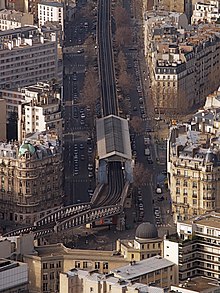Sèvres - Lecourbe (Métro Paris)
|
|
|
|---|---|

|
|
| Tariff zone | 1 |
| Line (s) |
|
| place | Paris XV |
| opening | April 24, 1906 |

Sèvres - Lecourbe is an above-ground station on line 6 of the Paris Métro .
location
The metro station is located in the Necker district in the 15th arrondissement of Paris . It lies lengthways across the median at the eastern end of Boulevard Garibaldi at the intersecting street Rue de Sèvres - Rue Lecourbe.
Surname
It is named after the Rue de Sèvres and the Rue Lecourbe. From 1907 to 1913 the station was only called “Rue de Sèvres” after the street leading to the south-western suburb of Sèvres . The General claude lecourbe (1759-1815) defended in 1815 the city of Belfort with only 8,000 soldiers for two weeks against a superior force of 40,000 Austrians.
When it opened, the station was called "Avenue de Suffren" after the street of the same name that opens there. The admiral Pierre André de Suffren (1726–1788) fought against the British in India and America.
history
The station went into operation on April 24, 1906 when the southern extension of Line 2 Sud from Passy to Place d'Italie was opened. On October 14, 1907, the previously independent line 2 Sud was abandoned and moved to the southwest end section of line 5 (then: Étoile - Gare du Nord ). The routes were changed again on October 6, 1942, so that line 6 has been running at the station since then.
Although line 10, which was opened there in 1937, runs in the immediate vicinity, it has no station at this point. The transfer station for line 10 is the La Motte-Picquet - Grenelle underground station, two stops to the west .
description
Sèvres - Lecourbe is the easternmost station of the western elevated section of line 6 coming from Passy. Its structure corresponds to most of the other high-altitude stations on this line. It is 75 m long and has 4.10 m wide side platforms on the two parallel tracks. Two longitudinal beams, each resting on a row of iron columns, carry the track bed and the inner edges of the platforms. Their outer edges and the side walls rest on two further longitudinal girders, which are supported by brick pillars. At the four corners of the station, a pillar protrudes over the roof for design reasons. The station has a gable roof - glass near the ridge - which also spans the tracks. The brick side walls show geometric ornaments on the outside.
Access is through a brick-built access building via a staircase that divides halfway up the east end of the station. Additional escalators were installed roughly in the middle of the platforms.
East of the station, the route bends in a curve onto Boulevard Pasteur and leads underground via a ramp.
vehicles
From around 1910 trains of the Sprague-Thomson type ran on the route . In July 1974 it was converted to vehicles with rubber tires, and the MP 73 series has been running on Line 6 since then .
Remarks
- ↑ At the similarly constructed elevated railway stations on Line 2 , the side walls are glazed and only the platforms, but not the tracks, are covered
Web links
literature
- Gérard Roland: Stations de métro. D'Abbesses à Wagram . 2003, ISBN 2-86253-307-6 .
Individual evidence
- ^ Gérard Roland: Stations de métro d'Abbesses à Wagram . Christine Bonneton, Clermont-Ferrand 2011, ISBN 978-2-86253-382-7 , pp. 199 .
- ^ Jean Tricoire: Un siècle de métro en 14 lignes. De Bienvenüe à Météor . 2nd Edition. La Vie du Rail, Paris 2000, ISBN 2-902808-87-9 , p. 210 .
- ↑ Jean Tricoire: op.cit. P. 51.
- ↑ Jean Tricoire: op.cit. P. 53.
| Previous station | Paris metro | Next station |
|---|---|---|
|
Cambronne ← Charles de Gaulle - Étoile |
|
Pasteur Nation → |
Coordinates: 48 ° 50 ′ 44 " N , 2 ° 18 ′ 34" E

